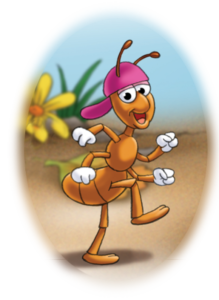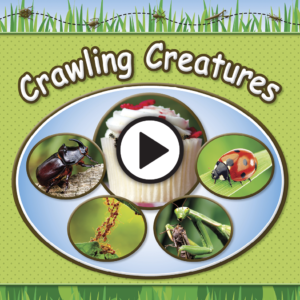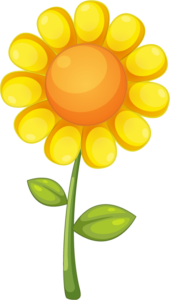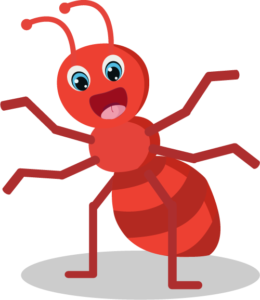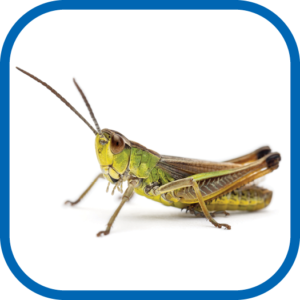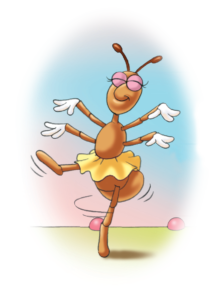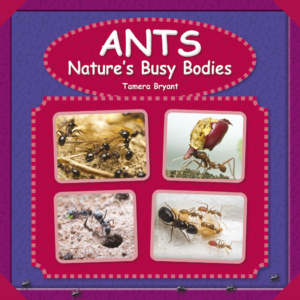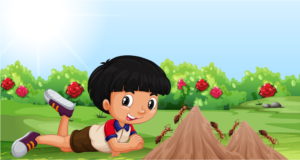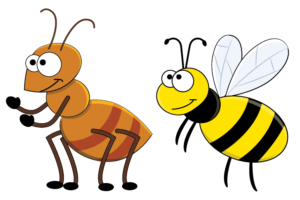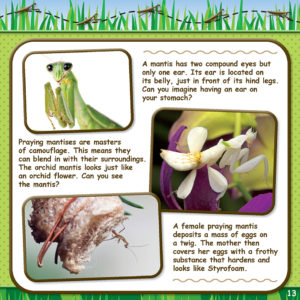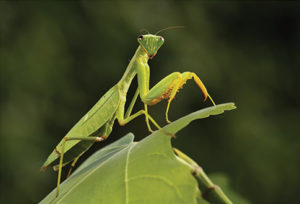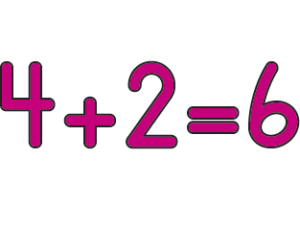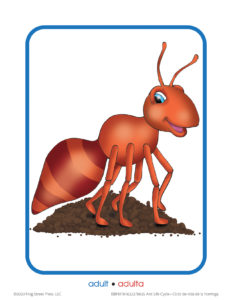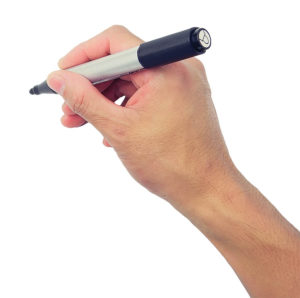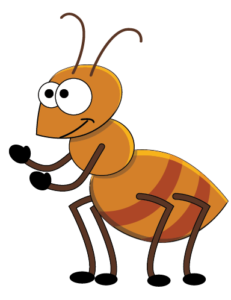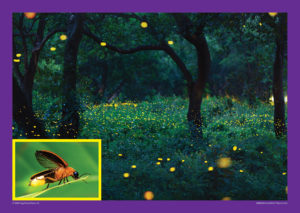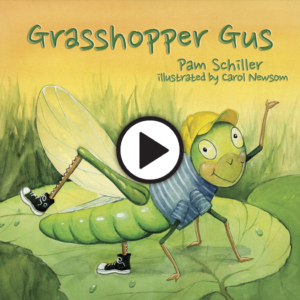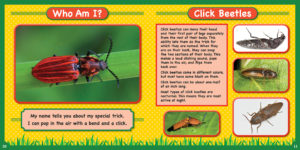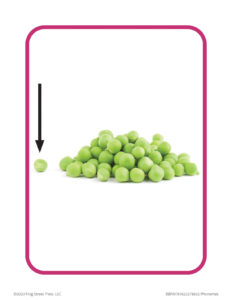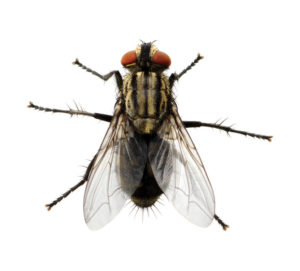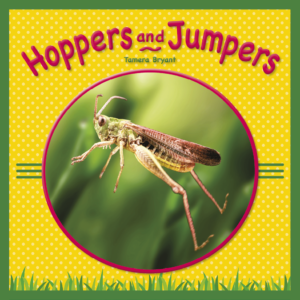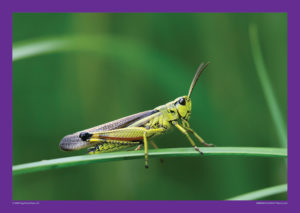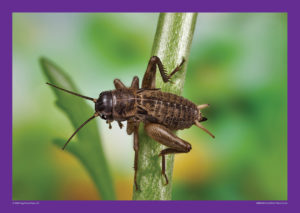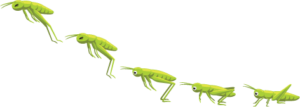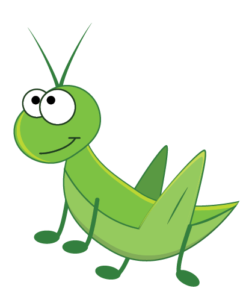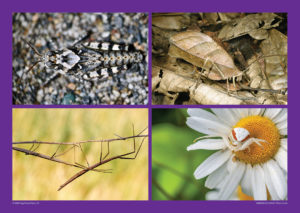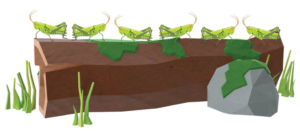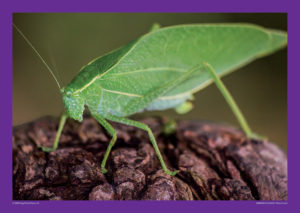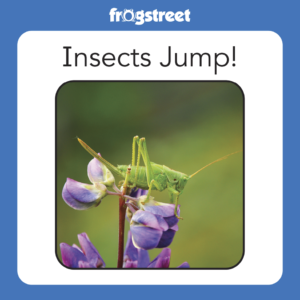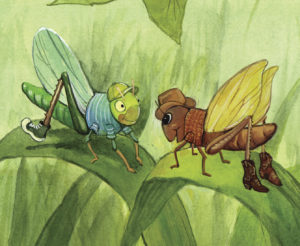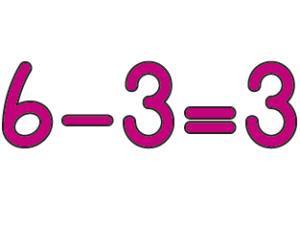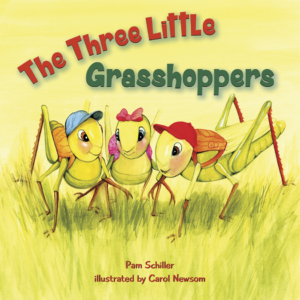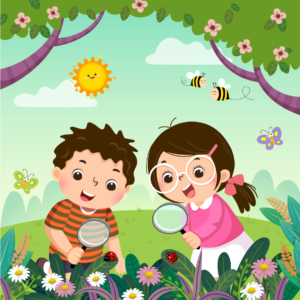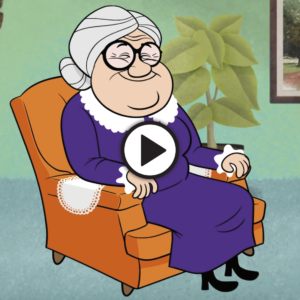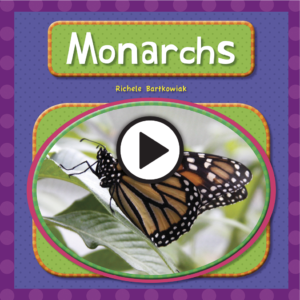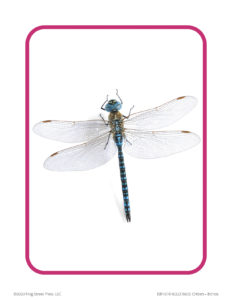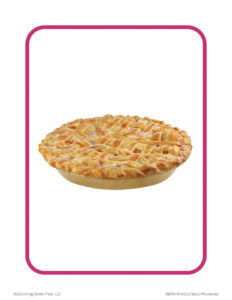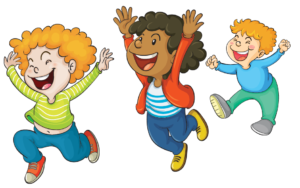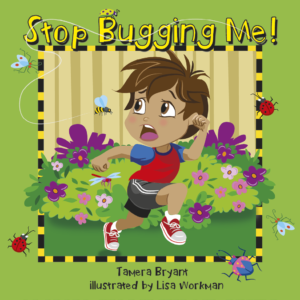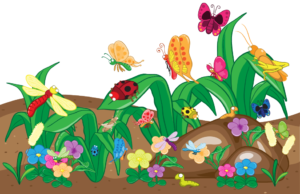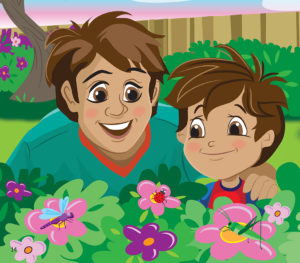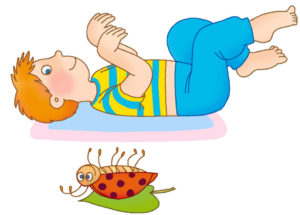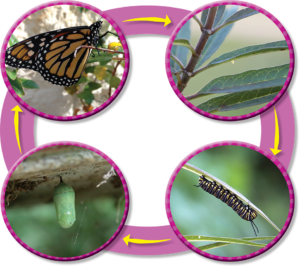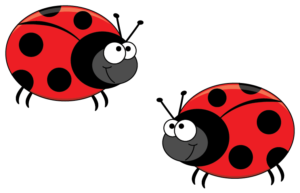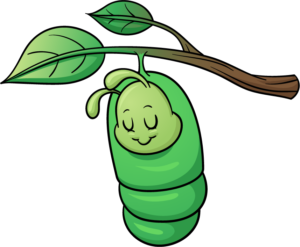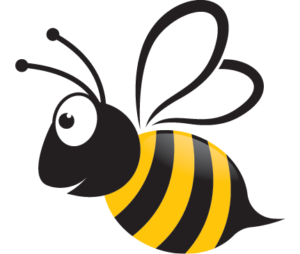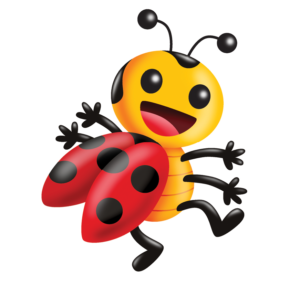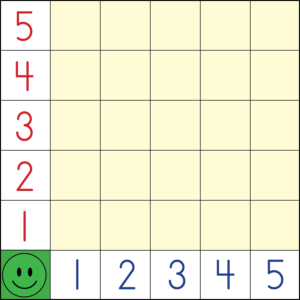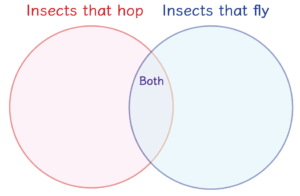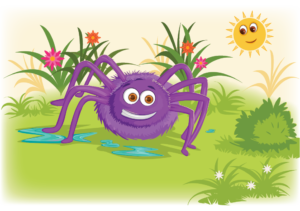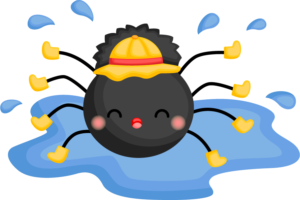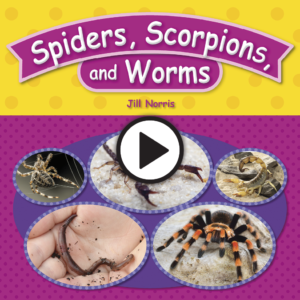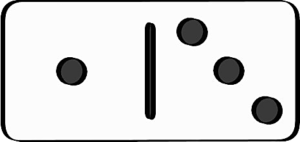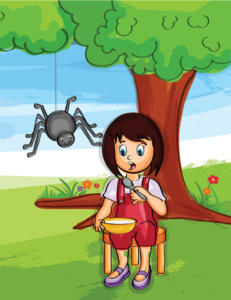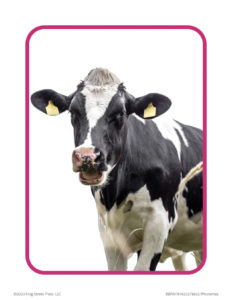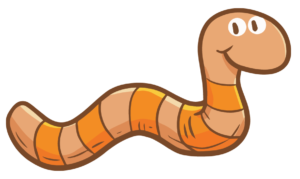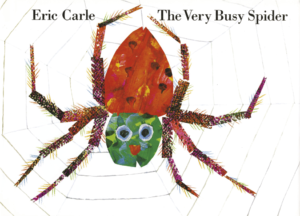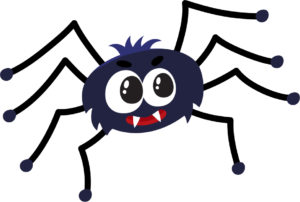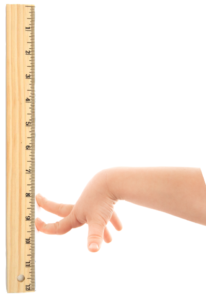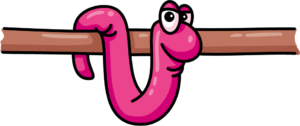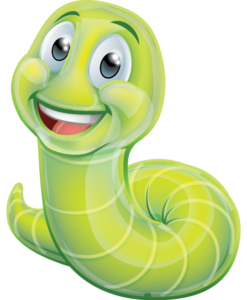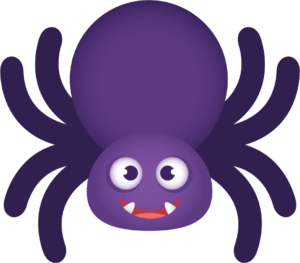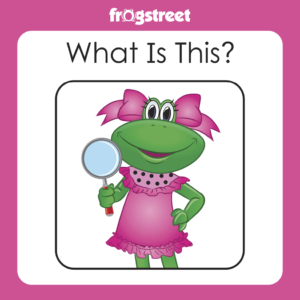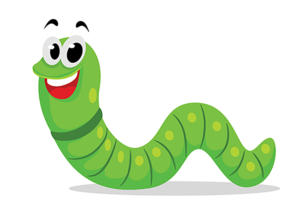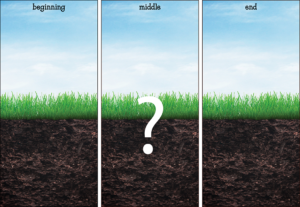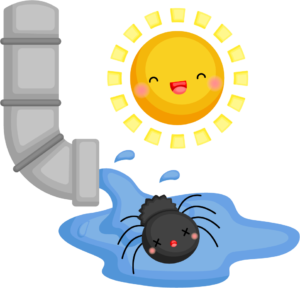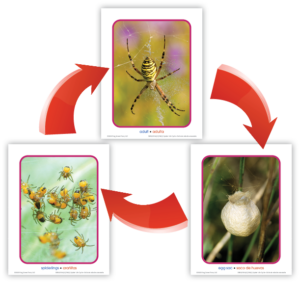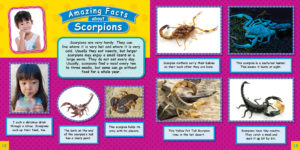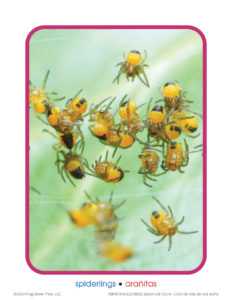Amazing Critters
Week 1: Crawling Critters
This week, your child will be learning about insects that crawl. Your child will discover that some insects are pests and others are very hard workers.
Word of the Week: insects
Before You Begin
Watch these videos to better understand the concepts your child will be learning this week. These are not videos you will watch with your child. These are just for you!

Books to Read
- Ants: Nature’s Busy Bodies eBook
- Crawling Creatures eBook
- Crawling Creatures Read-Aloud video
Supplies to Gather
- 0-5 dot cards (index cards, self-stick dots or markers)
- ants on a log: celery, filling (cream cheese or nut butter), raisins, plastic knife
- beans, seeds, pebbles, or leaves
- empty cardboard box
- flashlight
- glue
- handheld mirror
- journal
- magnets
- magnifying glass
- metal washer
- paints
- paper
- stamp pad (can use paper towel folded over with food coloring or a bit of paint)
- teddy bear or favorite stuffed animal
- writing tools
Daily Message
Insects have three body parts.
- Say the sentence. Ask your child to repeat it.
- Write the sentence as your child recalls each word.
- Have your child point to the uppercase letter at the beginning and the punctuation mark at the end.
- Write the letters n and o below the sentence. Invite your child to find and circle these letters in the sentence.

The Parade
March as you listen to the song “The Parade.” This is a song with many verses about ants marching in a parade. If your child tires of marching, sit and clap to the rhythm. Ask: What were some of the ants doing as they marched? Do you think these ants are real ants? Click image for lyrics.
Storytime
Watch the Crawling Creatures read-aloud video with your child. This is a nonfiction (informational) book. Ask: What did you notice about the book that let you know it was nonfiction? What crawling creatures have you seen? Where did you see them?
Card Game
Use 0-5 dot cards your child made during Theme 5 or you can make new ones. Your child will use these throughout the week. Shuffle the cards and place them face down on a flat surface. Have your child look at one card from the pile and use her fingers to show the number of dots on the card. Click image for sample set of dot cards.
An Insect Hunt
Talk a walk in your backyard or neighborhood looking for crawling insects. Carry a magnifying glass if you have one. Make sure your child remembers not to touch the bugs. If you know the name of an insect, tell it to your child. Encourage your child to point out insect body parts he can name.
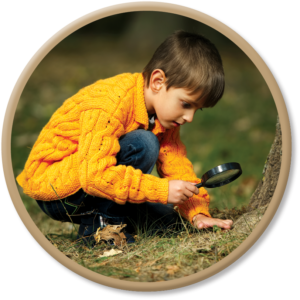
Insect Calming
Ask: If you were an insect, how might you do one of the calming strategies? Follow your child’s lead and do a calming strategy as an ant, beetle, or mantis. If your child needs help thinking of how to do this, suggest getting on all fours like an ant to S.T.A.R. or rolling tight into a ball like a roly-poly beetle and then relaxing (Drain).
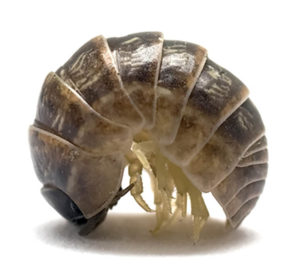
Daily Message
Insects move on six legs.
- Say the sentence. Ask your child to repeat it.
- Write the sentence as your child recalls each word.
- Have your child point to the uppercase letter at the beginning and the punctuation mark at the end.
- Write the letters m, n, and o below the sentence. Invite your child to find and circle these letters in the sentence.

Mystery Insects
Have your child practice blending sounds to say insect names. You will say a word slowly separating out the first sound from the rest of the word, such as /gr/-asshopper. Have your child blend the word parts to say the complete word: grasshopper. Then have your child point to the photo of the word. Click image to get started!
Storytime
Look at the cover of Ants: Nature’s Busy Bodies. Explain that this book tells about only one insect: ants. Read the book to your child. Ask: How were the ants in this book like ants that you have seen? What does it mean to be a “busy body”? Why does the author call the ants “nature’s busy bodies”?
Match Me
Mix up the 0-5 dot cards. Place the deck of six cards face down. Before removing each card from the deck, invite your child to use her fingers to guess how many dots she thinks might be on that card. Turn the card over. If the dots on the card match her fingers, make a tally mark on paper. Keep score of the number of matches.

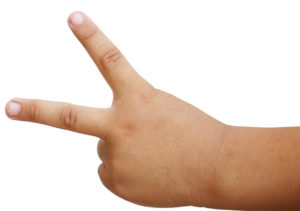
Insect Trail
Draw a trail on the outside of an empty cardboard box. Draw an insect on heavy paper and cut it out. Glue a metal washer to the back of insect cutout. Have your child use a magnet to guide the insect along the trail. Show how to place the insect by the start line on the outside of the box and use the magnet inside the box to move it.
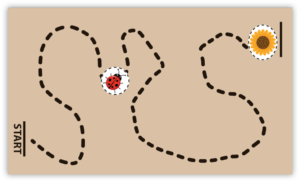
Scoop and Discover
Have your child carefully use a spoon to place a scoop of soil onto white paper. Ask: Are there any little creatures in the soil? Try scooping in several different areas. Do not touch insects you see. Just watch them. Encourage your child to also scoop a pile of dead leaves or pine needles. Ask: Where did you see insects? Why do you think the insects chose that spot?

Daily Message
Mantises eat mosquitoes and grasshoppers.
- Say the sentence. Ask your child to repeat it.
- Write the sentence as your child recalls each word.
- Have your child point to the uppercase letter at the beginning and the punctuation mark at the end.
- Write the letters M, m, n, and o below the sentence. Invite your child to find and circle these letters in the sentence.

Writing Together
Have your child imagine a “gathering.” You and your child might think about an upcoming birthday, a picnic with friends, or a tea party for stuffed animals. Make a list of the guests that you would invite to the party. “Read” the list together. Ask: What will we serve?
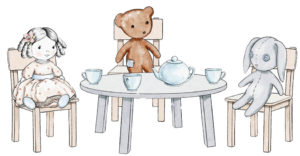
Storytime
Read Crawling Creatures. After reading, have your child remember the name of the insect that is a crawler nobody likes (cockroach). Ask: What insect likes to eat carpets and clothing? (silverfish) These two insects are called pests. Pests can bite, sting, get into food and destroy plants.
Join Dot Cards
Mix up the 0-5 dot cards. Place the deck of six cards face down. Tell your child to remove two cards from the top of the deck and count the dots on both cards. Ask: How many dots are there altogether? We call this number the sum. Have your child remove two more cards from the deck and add the dots until all cards have been played.
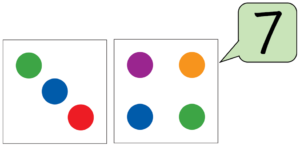
Camouflage
Reread page 13 in Crawling Creatures. Ask: Why is the mantis hard to see? Find objects, such paper or crayons, that are red and green. Invite your child to put the objects in a patch of grass. Ask: Which is easier to see? Why? Say: When a creature is the same color as its surroundings, it is harder to see. This is one kind of camouflage.
Stamp Pad Ants
Have your child touch a stamp pad with an index finger and press it three times on drawing paper to make the ant’s three body parts. (If you don’t have a stamp pad, use a paper towel folded over with food coloring or a bit of paint on it.) Have your child add six legs, two antennae, and eyes with a thin marker or crayon.
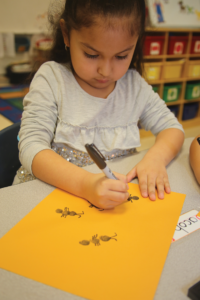
‘Round the Garden
Have your child imagine taking her favorite stuffed animal on a tour of your yard or garden. Repeat the rhyme as your child skips. When you say “tickle under here,” your child will stop and tickle the stuffed animal under the chin, arm, or ear. Repeat several times. Click image for verse.
Daily Message
A silverfish is not a fish.
- Say the sentence. Ask your child to repeat it.
- Write the sentence as your child recalls each word.
- Have your child point to the uppercase letter at the beginning and the punctuation mark at the end.
- Write the letters n and o below the sentence. Invite your child to find and circle these letters in the sentence.

My Journal
Have your child find the first blank page in her journal. Suggest your child draw some of the guests from the guest list you made yesterday. Your child might include drawings of some decorations or games. Encourage her to label the drawing with names. Assist as needed.
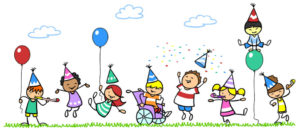
Storytime
Watch the Crawling Creatures read-aloud video. Encourage your child to answer the storyteller’s questions. Think about the amazing things you have learned about crawling insects. Ask: What is your favorite crawling insect? Why do you like it?
Number Sentence
Talk about the math symbols we use to write a number sentence. The + sign means put two numbers together. The = sign means the amount on the left side is the same amount as the right side. For example: 4 + 2 = 6. We put 4 and 2 together and that equals or is the same as 6. Click image to get started!
Double It
Mix up the 0-5 dot cards. Place the deck of six cards face down. Have your child remove one card one from the pile and turn it over. Have her place the card in front of a handheld mirror. Ask: How many dots now? Point out that the mirror reflects a second image. You see a double image. (2 dots + 2 dots) Ask: How many dots in all?

Ant’s Life Cycle
Remind your child how different animals change as they grow into adults. Read pages 7-9 in Ants: Nature’s Busy Bodies to see photos of the ant’s life cycle. After reading, click image to order the ant’s life cycle stages.
Garden Mural
Cut open a paper bag to make a large drawing surface. Work together with your child to create a mural (large wall painting) of insects in a garden. Add other things you might see in a garden such as dirt and flowers. Continue adding to the mural for several days.

Commitments
Ask: Why do we make commitments in our learning family each day? Remind your child that it is important to use Walking Feet, Listening Ears, Helping Hands and Big Voices to help keep everyone safe. Have your child think of a time of day that he wants to be more helpful. Choose an agreement that will help him to do that.
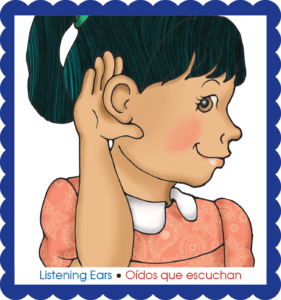
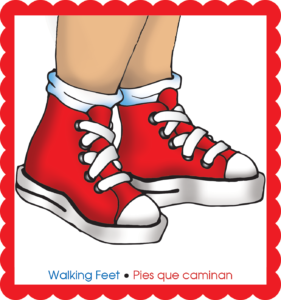
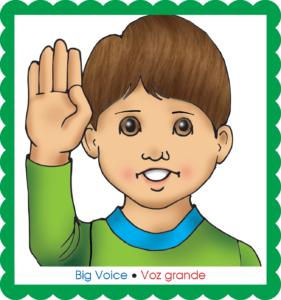
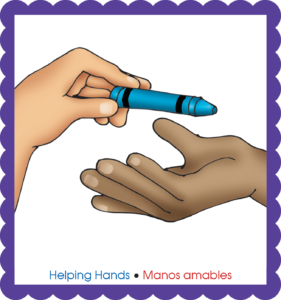
Daily Message
Do ant colonies have many workers?
- Say the sentence. Ask your child to repeat it.
- Write the sentence as your child recalls each word.
- Have your child point to the uppercase letter at the beginning and the punctuation mark at the end.
- Write the letters m, n, and o below the sentence. Invite your child to find and circle these letters in the sentence.

Writing Letters
Focus: Mm, Nn, Oo
Review how to write the letters. Have your child watch as you write a letter saying the strokes. Have your child write the letter with a finger on the floor repeating the strokes. Then have your child practice writing on paper. Repeat for each letter. Click image for letter formation strokes.
Storytime
Read Ants: Nature’s Busy Bodies. Then read about ants in Crawling Creatures (pages 8-9). Have your child compare the information about ants in the two books. Ask: Why do you think some facts were in both books? What questions do you still have about ants? Click image to compare facts.
My Number Story
Give your child paper, markers, and small items (such as black beans) that look like insects. Have your child draw the setting for a number story in which insects join together. Then have your child use the “insects” (beans) to show the story on the picture. Encourage him to write a number sentence to go with the number story.
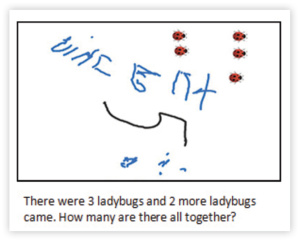
Firefly Flash
Play a game of Firefly Flash with your child. Explain that the light a firefly makes often blinks on and off. Go with your child into a darkened room. Blink a flashlight on and off three times. Have your child use her fingers to show how many blinks she saw. Try different numbers (up to five or fewer). Click image to learn more about fireflies.
Ants on a Log
Help your child prepare a snack called “ants on a log.” Give your child a 3-inch stalk of celery. Have your child spread a tablespoon of filling (cream cheese or nut butter) in the celery stalk with a plastic knife. This is the log. Top the log with raisins (ants). Ask: How many ants are on your log?
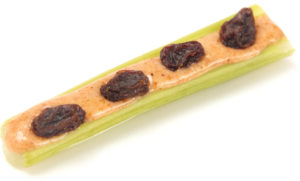
Add It Up
Help your child use small objects to practice combining two sets. Tell a simple story: Two insects are chewing on a leaf. (Put two stones on table.) They decided to share so they call three friends to join them. (Put three more stones on table.) Ask: How many insects are there in all? Count. Repeat changing the numbers.

Amazing Critters
Week 2: Hopping Critters
This week, you and your child will learn about insects that hop or jump. You will learn which ones are pests and which ones are hard workers.
Word of the Week: catapult
Before You Begin
Watch these videos to better understand the concepts your child will be learning this week. These are not videos you will watch with your child. These are just for you!

Songs to Sing

Books to Read
- Grasshopper Gus eBook
- Grasshopper Gus Read-Aloud video
- Hoppers and Jumpers eBook
- Insects Jump! eBook
- The Three Little Pigs eBook
Supplies to Gather
- 0-5 dot cards (index cards, self-stick dots or markers)
- catapult: plastic spoon, small box or block, tape, ball of paper, pie pan
- clothespins
- flashlight
- grasshopper sounds: craft stick, comb
- hopping grasshopper: masking tape, small ball, box
- journal
- masking tape
- paper
- paperclips, clothespins, or twigs
- ruler
- straw, water or juice on a plate
- string or yarn
- tape measure
- television remote control
- writing tools
Daily Message
An insect quickly crawled on my knee.
- Say the sentence. Ask your child to repeat it.
- Write the sentence as your child recalls each word.
- Have your child point to the uppercase letter at the beginning and the punctuation mark at the end.
- Write the letters q and r below the sentence. Invite your child to find and circle these letters in the sentence.

Vocabulary
Teach your child the difference between hop (hop on one foot in place) and jump (jump from two feet to another place). The Word of the Week is catapult. Catapult means to quickly move up or ahead. Have your child show the movement. Ask: Is it easier to catapult if you hop or jump? Click image to enlarge word.
Storytime
Watch the Grasshopper Gus read-aloud video. Ask: Who are the two main characters in this story? Do you think they are real or make-believe insects? Why? Say: Even though this book is make-believe, it includes many facts about grasshoppers and crickets. Make-believe stories can include information that helps us learn.
Taking From
Place a set of 15 paper clips in the center of the table. Mix the 0-5 dot cards. Place the deck of six cards face down. Take turns with your child removing one card at a time, turning it over, and taking that many paper clips. Continue taking turns until all cards are played and all paper clips are gone. Compare to see who has the most paper clips.


Nocturnal Activity
Turn to pages 10-11 in Hoppers and Jumpers. Remind your child that some insects are nocturnal, which means they are active at night. Go outside at night with your child. Take a flashlight. Invite your child to listen for insect sounds, such as click beetles or crickets chirping. Look for insects that are attracted by and gather near outdoor lights.
Build a Catapult
Tape the handle of a plastic spoon to a small box or block so that the bowl of the spoon extends off the side of the block. It should bend downward when you push it and spring back up when you let go. Place a small ball of paper in the spoon. Bend the spoon bowl downward and release. See if your child can catapult the paper ball into a pie pan target.
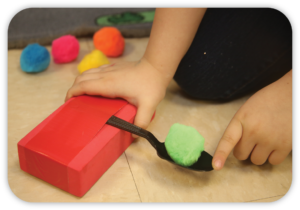
Grasshopper Breathing
Ask: How might a grasshopper take three deep breaths? Show one way by taking a deep breath and then exhaling a little as you hop three times. Encourage your child to think of another way. Try the new breathing strategies throughout the day.
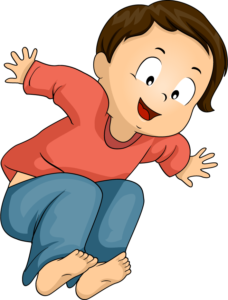
Daily Message
A grasshopper jumped on my toe.
- Say the sentence. Ask your child to repeat it.
- Write the sentence as your child recalls each word.
- Have your child point to the uppercase letter at the beginning and the punctuation mark at the end.
- Write the letters p and r below the sentence. Invite your child to find and circle these letters in the sentence.

Blend Sounds
Have your child practice blending sounds to form words. You will say a word slowly separating it into two parts as you say it, such as /p/-ea. Have your child blend the two sounds to say the complete word: pea. Then have your child point to the photo of the word. Click image to get started!
Storytime
Explain that Hoppers and Jumpers is an informational book. Your child will be learning about different insects that hop and jump. The book has a rhyming riddle about each insect. Read the riddle and show the photo. After your child has a chance to guess the name of the insect, read the information about the insect on the next page.
Finger Subtraction
Mix up the 0-5 dot cards. Place the deck of six cards face down. Have your child show five fingers on one hand. Remove a dot card from the deck and show it to your child. Tell him to lower (subtract) that many fingers. Continue having your child show five fingers and lower as many fingers as dots on each card until all cards are played.

Catapult Jump
Challenge your child to use her legs to catapult her body forward. Have her try two different jumps:
- Squat halfway to the ground with knees slightly bent. Jump.
- Squat nearer to the ground, increasing the bend in knees. Jump.
Measure the two jumps with string or yarn. Ask: Which squat position helped you jump the farthest? Why?

Daily Message
Leafhoppers have two pairs of wings.
- Say the sentence. Ask your child to repeat it.
- Write the sentence as your child recalls each word.
- Have your child point to the uppercase letter at the beginning and the punctuation mark at the end.
- Write the letters p and r below the sentence. Invite your child to find and circle these letters in the sentence.

Writing Together
Look at the photos in Hoppers and Jumpers. Have your child tell how each insect moves. Have your child finish the sentence: A __________ can jump. Write your child’s sentences. Have her point to the first word. Say: This word is A. Have her point to the last word in the sentence. The word is jump. Read the sentences together.
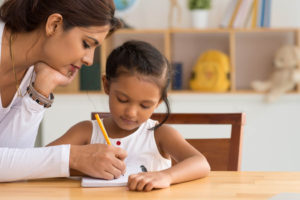
Grasshopper
This verse is about a pair of grasshoppers playing the game “Leap Frog.” Show your child how to play the game before reading the verse: Your child takes a crawling position. Put your hands on his back and jump over him. You take the crawling position in front of him. He stands and “jumps” over you. Ask: Do you think the insects liked this game? Click image for verse.
Storytime
Read page 9 in Hoppers and Jumpers. Look carefully at the katydid. Ask: Why do you think it is hard to see the katydid? The katydid is camouflaged. Camouflage is when an animal or insect looks like its surroundings. Click image to find the hiding insects.
Backward Jump
Invite your child to practice jumping and counting backwards. Start at ten and count down to one for each hop backward. Practice walking backwards before jumping. For extra practice counting backwards, show your child a ruler. Find the 10 and move to the left, saying the name of each numeral (10, 9, 8, 7, 6, 5, 4, 3, 2, 1).

Grasshopper Sounds
Have your child rub a craft stick (or pencil) gently across the teeth of a comb to imitate the sound that grasshoppers make when they rub their wings together. Suggest your child try moving the stick in different ways: slowly, quickly, gently and then with a little more force. Warn him that too much force will break the teeth of the comb.
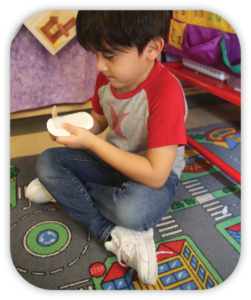
Daily Message
Do katydids eat pie? What do they eat?
- Say the sentences. Ask your child to repeat them.
- Write the sentences as your child recalls each word.
- Have your child point to the uppercase letters at the beginning and the punctuation marks at the end.
- Write the letters p and o below the sentence. Invite your child to find and circle these letters in the sentence.

My Journal
Read the book Insects Jump! Encourage your child to read with you. Read the incomplete sentence on the last page: I can __________ like an insect. Have your child draw ways she can move like an insect on the first blank page of her journal. Label the page with the completed sentence.
Insect Songs
You have learned several insect songs. You and your child may know others. Think of some of your favorites. Ask: Is the insect in the song like a real insect or is it a make-believe insect? How do you know? Sing your favorite song together and then sing your child’s favorite.
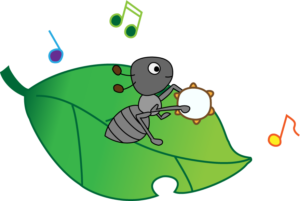
Storytime
Watch the Grasshopper Gus read-aloud video. Ask: How are Gus the grasshopper and Crandall the cricket alike? How are they different? Use a chart to compare the two insects. Click image to see an example.
Number Sentence
Talk about the math symbols we use to write a subtraction number sentence. The – sign means to take apart. The = sign means the amount on the left side is the same amount as the right side. For example: 6 – 3 = 3. We take 3 from 6 and that equals or is the same as 3. Click image to get started!
Plus and Minus
Help your child find the + and – volume control on the TV remote control. Turn the TV on. Have your child listen to what happens when he presses each symbol. Ask: Which button lowers (takes away) sound? Which button makes sound louder (adds)? Remind your child that the + sign in math increases (more) and the – sign decreases (takes away).
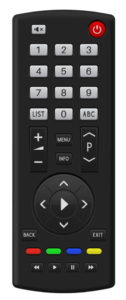
Can You Spring?
Ask: What does it mean to spring? (jump up quickly) Try springing. The springtail, a tiny hopping insect, is an expert at jumping up quickly. It has a forked “tail” called a furcula at the end of its abdomen. When the tiny bug wants to jump, the furcula acts like a spring and pops it into the air. Ask: Is springtail is a good name for this insect? Why?
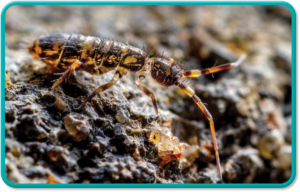
Hopping Grasshopper
Place a strip of masking tape on the floor for a throw line. Have your child stand or squat behind the line and bounce a small ball into a box with only one bounce. Draw eyes on the ball to make it into a “hopping grasshopper.” Ask: How many times did you try before you got the “grasshopper” into the box? What did you do to get better?
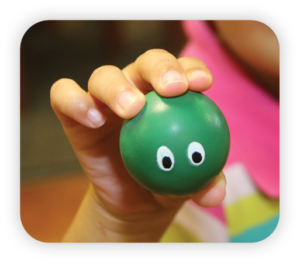
Stopping Can Help
Remind your child that stopping can help her do her job to keep learning time safe. Give some examples: If you get excited and start to run, you can STOP and practice walking. If you begin to talk when someone else is talking, what can you do? That’s right! STOP and practice listening. S.T.A.R. is one way to remember to stop. Stop, take a take breath and relax.
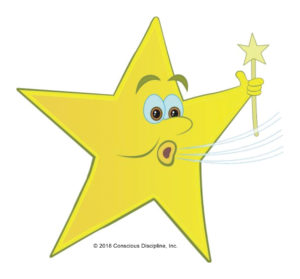
Daily Message
Fleas bit the quiet cow.
- Say the sentence. Ask your child to repeat it.
- Write the sentence as your child recalls each word.
- Have your child point to the uppercase letter at the beginning and the punctuation mark at the end.
- Write the letters q and o below the sentence. Invite your child to find and circle these letters in the sentence.

Writing Letters
Focus: Pp, Qq, Rr
Review how to write the letters. Have your child watch as you write a letter saying the strokes. Have your child write the letter with a finger on the floor repeating the strokes. Then have your child practice writing on paper. Repeat for each letter. Click image for letter formation strokes.
Storytime
Show the cover of The Three Little Grasshoppers. You and your child read this book in Theme 4 when you were learning to compare. Read the book. Ask: How are these make-believe characters like real grasshoppers? How are they different?
My Number Story
Give your child paper, markers, and small items that look like grasshoppers (clothespins). Have your child draw a setting (story mat) for a number story in which grasshoppers are separated. Then have your child use the “grasshoppers” to show the story on the setting. Write a number sentence to tell the beginning, middle and end (difference).

Compare Moves
Fold a sheet of drawing paper in half. Draw a line down the middle. Have your child draw how an insect moves on one side of the paper. Have him draw how he moves on the other. Remind your child to label the drawing with the insect name and his name. Help write what your child says as he describes the way the insect moves (hop, jump, run, walk).
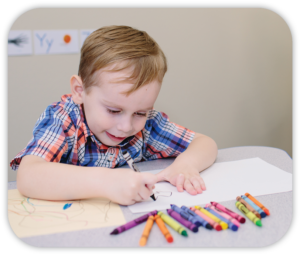
Insect Hiding Places
Remind your child that insects often hide in their habitats. Their camouflage protects them making them difficult to see. Look around your yard or at a park where insects might be hiding. Take photos of any insects you find.
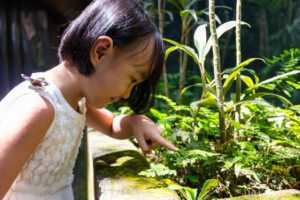
Amazing Critters
Week 3: Flying Critters
This week, your child will learn about insects that fly including bees, mosquitoes, ladybugs, and butterflies. Your child will learn how some insects like the butterfly change over their lifetime.
Word of the Week: proboscis
Before You Begin
Watch these videos to better understand the concepts your child will be learning this week. These are not videos you will watch with your child. These are just for you!

Books to Read
- Crawling Creatures eBook
- Hoppers and Jumpers eBook
- Monarchs eBook
- Monarchs Read-Aloud video
- Stop Bugging Me! eBook
Supplies to Gather
- bucket or basket
- butterfly snack: cream cheese or nut butter, celery stalk, thin apple slices, pretzel sticks
- classical music
- cup
- flashlight
- handheld mirror
- journal
- ladybug spray: water, sugar, yeast, spray bottle
- orange and black paper strips or scarves
- paper
- paperclips
- pennies
- toothpicks
- tray
- writing tools
Daily Message
Some flying insects are helpful. Some are pesky.
- Say the sentences. Ask your child to repeat them.
- Write the sentences as your child recalls each word.
- Have your child point to the uppercase letters at the beginning and the punctuation marks at the end.
- Write the letters S, s, and t below the sentence. Invite your child to find and circle these letters in the sentences.

Vocabulary
This Word of the Week is a scientific word that even some adults may not know. A proboscis (prә-bä-skәs) is part of the mouth of some insects. It is a long thin tube. It lets insects, like mosquitos and flies, suck their food like they are sipping from a straw. Click image to enlarge word.
I Know an Old Lady
Watch the music video “I Know an Old Lady.” This musical make-believe story begins when a lady swallows a fly. Ask: What would you do if a fly flew in your mouth?
Storytime
Watch the Monarchs read-aloud video. After the story, talk about some of the things you learned about the Monarch butterfly. Ask: What was surprising to you about these butterflies?
Five Butterflies
Give your child five same-sized paper squares. Have your child use crayons or markers to draw a yellow butterfly on one side of each square and a red butterfly on the other side of each square. Save the butterflies for a math activity tomorrow.
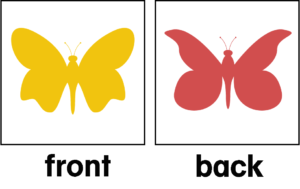
Butterfly Snack
Build a butterfly snack with your child. Spread cream cheese or nut butter onto a 3-inch celery stalk. Add thin apple slices for wings. Attach two pretzel sticks for antennae. Enjoy nibbling this treat together!
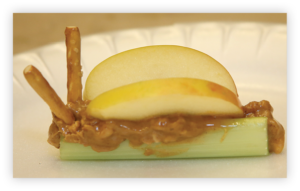
Breathe and Fly
You and your child can choose a flying insect to copy. Fly slowly around the room or the park. Take three deep breaths together. Then exhale about twice as long as you inhale. Remember to breathe in through your nose and breathe out through your mouth.

Daily Message
Are flies a delicious meal
for frogs and lizards?
- Say the sentence. Ask your child to repeat it.
- Write the sentence as your child recalls each word.
- Have your child point to the uppercase letter at the beginning and the punctuation mark at the end.
- Write the letters s, m and o below the sentence. Invite your child to find and circle these letters in the sentence.

Blend Sounds
Have your child practice blending sounds to form words. You will say a word slowly separating it into two parts as you say it, such as /p/-ie. Have your child blend the two sounds to say the complete word: pie. Then have your child point to the photo of the word. Click image to get started!
Storytime
Show Stop Bugging Me! and read the title. Explain that bugging means the same thing as bothering. Ask: What do you think is bugging (bothering) the boy? Say: This is a fiction story. It is not true. But some of the flying insects in the story are real. Have your child listen for flying insects in the story that she has seen.
Five Busy Butterflies
You and your child will play a game with the double-sided butterfly squares you made yesterday. Place the five squares in a bucket or basket. Have your child shake the basket and then turn it upside down as the butterflies “fly” out. The butterflies will land either on red or yellow. Click image to get started!
Domino Image
Draw a large two-section domino shape on a piece of paper. Give your child the paper and some pennies. Click each colored dot (one at a time) to display a domino. Your child will look at it for 5 seconds and then without looking, place pennies on her paper domino so they are in the same position as the dots on the domino she saw. Say: You will need to notice how many dots are on the top and on the bottom.
Lovely Ladybug
Make a special mixture to spray on bushes to attract ladybugs. Have your child help you mix 5 cups of water, 1/2 cup of sugar, and 1/2 cup of yeast in a large bucket. Pour this mixture into a spray bottle for your child to spray on outdoor bushes. Spray the bushes several times to create a build-up that will attract ladybugs.
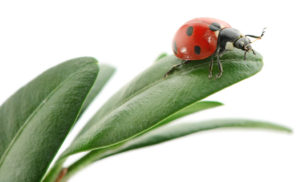
Find the Firefly
Gather family members for this hide-and-seek game. Have your child be the “firefly” and give him a flashlight. Turn off the lights. Have everyone close their eyes while the firefly finds a place to hide. The firefly will flash the flashlight on and off quickly. Ask family members to point to the hiding place.
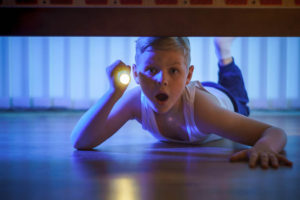
Daily Message
Ouch! A mosquito bit me.
- Say the sentences. Ask your child to repeat them.
- Write the sentences as your child recalls each word.
- Point out that an exclamation point shows excitement. Have your child read that sentence as if he had been bitten by a mosquito!
- Write the letters s, t, and u below the sentence. Invite your child to find and circle these letters in the sentence.
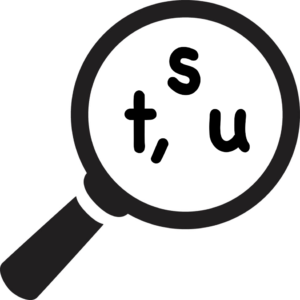
Writing Together
Look at the pictures in Stop Bugging Me! Have your child point to and name the insects Zack saw. Ask: What insects have you seen? Write I saw a __________ . on paper. Have your child say the name of an insect. Write the insect’s name to finish the sentence. Read the sentence together as you move your hand under the words.
Storytime
Show page 16 of Monarchs. Help your child remember the changes that this insect goes through (egg, caterpillar, chrysalis, butterfly). Say: These changes are called a life cycle. Teach your child a chant and its actions to help her remember the changes. Click image for chant.
3-Dot Domino
Use the blank domino shape you made yesterday. Have your child place three pennies on the domino. Ask: If you place two pennies at the top, how many do you have left to place at the bottom? Have your child make different top and bottom combinations of 3, such as 3 and 0, 1 and 2, or 0 and 3. Click image for possible combinations.
Butterfly Symmetry
Fold a sheet of paper in half lengthwise. Invite your child to draw half of a butterfly on the left-side of the folded paper. (Make sure the paper remains folded when your child draws). Hold the drawing parallel to a mirror. The butterfly’s body will be the same on both sides (symmetrical). Unfold the paper. Have your child draw the other half of the butterfly.
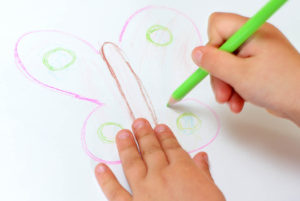
Insect Moves
Make a three-column chart. Label the columns: crawl, jump, fly. Point to each label and have your child show the move. See how many insects the two of you can name and add to the chart. Ask: Where would you draw a bee, a roly-poly, a grasshopper? Could some insects go in more than one column?

Daily Message
A bee stores honey in a beehive.
- Say the sentence. Ask your child to repeat it.
- Write the sentence as your child recalls each word.
- Have your child point to the uppercase letter at the beginning and the punctuation mark at the end.
- Write the letters s, t, and v below the sentence. Invite your child to find and circle these letters in the sentence.

My Journal
Talk with your child about favorite insects. Ask: What is your favorite? Have your child locate the first blank page in his journal and draw his favorite. Encourage your child to label the insect and its parts. Help as needed.

Little Caterpillar
Teach your child this rhyme about a caterpillar. Your child is learning about how some insects go through different stages in their life cycle. In this rhyme, the caterpillar spins a chrysalis around itself and emerges as a butterfly. Encourage your child to act out the changes as you read the rhyme. Click image for rhyme.
Storytime
Watch the Monarchs read-aloud video with your child. Say: The milkweed plant plays an important part in a monarch butterfly’s life. What are some things it does? What do you think would happen if there were no milkweed plants?
Hiding Game
Ask your child to count out five paper clips. Have him close his eyes while you hide two under a cup. Have him open his eyes. Ask: How many are hiding? If your child does not know, have him match the three paper clips to each finger on his hand. Show that two fingers do not have a match. Continue playing to practice other combinations of five.
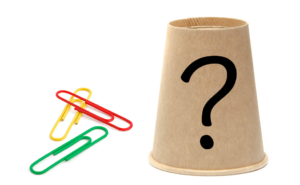
4-Dot Domino
Use the blank domino shape. Have your child place four pennies on the domino. Ask: If you place four pennies on one side, how many would you have left to place on the other side? Have your child make different combinations of 4.
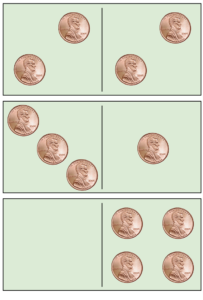
Butterfly Dance
Remind your child that while butterflies are beautiful to watch, people should not touch them. Say: If you touch a butterfly, it will lose some of the scales on its wings. The scales give it beautiful colors and help it fly. Play some classical music and invite your child to “fly” gracefully like a monarch butterfly using orange and black paper strips or scarves as wings.

Fly to the Finish
Choose a start line and a finish line. Your child will begin crawling on the ground when you say “crawl.” When you say “fly” your child will jump up and “fly” toward the finish line. Say “crawl” and “fly” to change your child’s movements. When your child crosses the finish line, the round is over. Ask: Would you rather be a crawling insect or a flying insect? Why?

Daily Message
Honey is very delicious.
- Say the sentence. Ask your child to repeat it.
- Write the sentence as your child recalls each word.
- Have your child point to the uppercase letter at the beginning and the punctuation mark at the end.
- Write the letters s, v, and o below the sentence. Invite your child to find and circle these letters in the sentence.

Writing Letters
Focus: Ss, Tt, Uu, Vv
Review how to write the letters. Have your child watch as you write a letter saying the strokes. Have your child write the letter with a finger on the floor repeating the strokes. Then have your child practice writing on paper. Repeat for each letter. Click image for letter formation strokes.
Five Little Ladybugs
The song “Five Little Ladybugs” is a musical math problem. Hold up the fingers on one hand to represent the five ladybugs. Lower one finger each time a ladybug goes away. Ask: Why do you think the one ladybug called her friends? What would a ladybug jive look like? Click image for lyrics.
Storytime
Some flying insects are helpful. As you read Stop Bugging Me! today have your child listen for helpful insects (bee, butterfly, firefly, dragonfly, ladybug). The final page of the book shows Zack and his family enjoying a firefly show. Ask: What insects make you happy?
How Many Wings?
Today your child will build butterflies with toothpicks and paper clips. Have your child use three toothpicks as the bodies of three butterflies. Then have her place a paper clip as a wing on each side of the toothpick. Ask: If there are three butterflies, how many wings will there be altogether? Encourage your child to count the paper clips (6) to figure out the total number (sum) of wings.
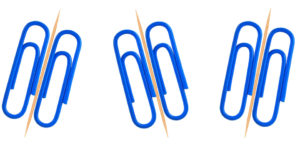
Butterfly Grid
Today your child will place “butterflies” in a grid garden. To move on the grid, butterflies must fly to the right a certain number of spaces and then fly straight up another number of spaces. Create the grid on paper. Have your child use markers to draw butterflies in the correct spaces. Click image to get started!
Hop, Fly or Both?
Draw a chart with two overlapping circles to show how some insects move. Think of insects you have studied and how they move. When your child names an insect, help her write its name or draw a picture of it in the correct circle. Insects that both hop and fly belong in the overlapping section. Click image to get started!
Combinations of 5
Point out that one side of a penny has a face (heads) and one side doesn’t (tails). Place five pennies in a small cup. Have your child shake the cup and spill the pennies onto a tray. Count the “heads” and “tails.” Remind your child that the two groups form one group of five pennies. For example: 3 heads plus 2 tails equals 5. Repeat to find other combinations.
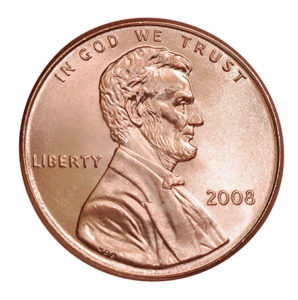
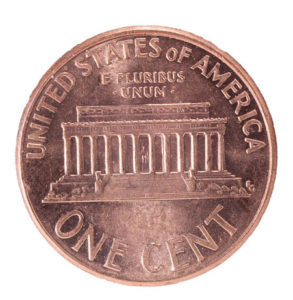
Amazing Critters
Week 4: Spiders, Scorpions, Worms
This week, you and your child will learn about three critters that many people don’t like: spiders, scorpions, and worms. You will talk about how to stay safe around these critters and how some of them can be very helpful.
Word of the Week: arachnids
Before You Begin
Watch these videos to better understand the concepts your child will be learning this week. These are not videos you will watch with your child. These are just for you!

Books to Read
- Spiders, Scorpions, and Worms eBook
- Spiders, Scorpions, and Worms Read-Aloud video
- The Very Busy Spider eBook
- What Is This? eBook
Supplies to Gather
- 0-5 dot cards (index cards, self-adhesive dots or markers)
- clothespins
- journal
- masking tape
- paper
- paper plate
- paper plate
- paperclips
- rocks
- ruler
- short pieces of yarn or chenille wire
- small blocks
- spider hat: black construction paper, glue or tape, wiggle eyes
- tweezers
- white chalk
- writing tools
Daily Message
Spiders and scorpions have eyes. Worms do not have eyes.
- Say the sentences. Ask your child to repeat them.
- Write the sentences as your child recalls each word.
- Have your child point to the uppercase letters at the beginning and the punctuation marks at the end.
- Write the letters W, y, and p below the sentence. Invite your child to find and circle these letters in the sentence.

Vocabulary
Arachnids are small animals with two body parts and eight legs. (Remind your child that an insect has three body parts and six legs.) Use the Word of the Week at home as often as you can. You might say: That little spider is an arachnid. Do you see its eight legs? Click image to enlarge word.
Eensy Weensy Spider
“Eensy Weensy Spider” is another version of this familiar song about a little spider who climbs a waterspout. In this version, the spider tries swimming and waterskiing as well as climbing. Enjoy listening to the song. Ask: If you were a spider what sports would you like to try? Click image for lyrics.
Storytime
Watch the Spiders, Scorpions, and Worms read-aloud video with your child. The book compares a child to some unlikely creatures. Help your child tell how she is different from spiders, scorpions, and worms. Have your child respond to the book’s questions.
Paper Plate Spider
A spider’s legs are attached to its body and the two sides of its body are the same. It is symmetrical. Have your child use clothespins and a paper plate to make a spider. Ask: If each clothespin is one leg, how many clothespins will you need for the spider’s legs? (8) How will you arrange the eight legs so there are the same number on both sides?
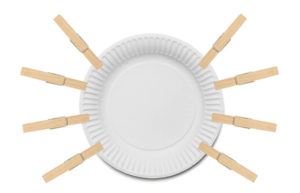
Dough Worms
Invite your child to roll play dough into “worms.” Encourage her to measure and compare the “worms” to find out which is the longest and shortest. Ask: What did you need to do with the dough to make the worm longer? Are your worms thin or fat? Can you make your worms wiggle?
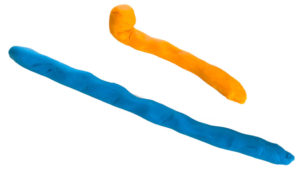
Who’s Hiding?
Place a sheet of white paper underneath a bush. Gently shake the bush to see what little creatures fall onto the paper. Have your child look (without touching) at the little creatures. Ask: Is it an insect? Is it an arachnid? How do you know? Can it fly or crawl?

Daily Message
Spiders, scorpions, and worms have zero ears.
- Say the sentence. Ask your child to repeat it.
- Write the sentence as your child recalls each word.
- Have your child point to the uppercase letter at the beginning and the punctuation mark at the end.
- Write the letters w, z, and v below the sentence. Invite your child to find and circle these letters in the sentence.

Blend Sounds
Have your child practice blending sounds to form words. You will say a word slowly separating it into two parts as you say it, such as /c/-ow. Have your child blend the two sounds to say the complete word: cow. Then have your child point to the photo of the word. Click image to get started!
Storytime
Before you read have your child predict what a spider might do that would keep it very busy. Read The Very Busy Spider. Ask: What did the spider do that kept it busy all day? Have you ever seen a spider spinning a web? Have you seen a spider web? Where?
Itsy Bitsy Spider
Sing “Itsy Bitsy Spider.” Hold a ruler upright within your child’s reach. Invite your child to “finger walk” (alternating her pointer and middle finger back and forth along the edge) like a spider up the ruler. Have your child count each step as she finger walks. Ask: How many “steps” did it take you to reach the top?
Worm Race
Use masking tape to create a start and finish line. Have your child lie on the floor face down and wiggle like a worm. Challenge your child to wiggle from the start line to the finish line. Remind him that since worms have no arms or legs, he also cannot use his arms or legs. Ask: Why was it hard to move?
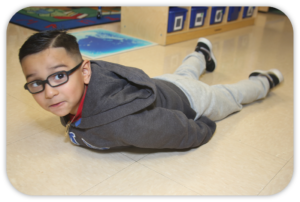
Spider Hat
Have your child make a spider hat. Make a paper headband of construction paper. Show how to fold eight black paper strips back and forth (accordion fold) to create spider legs. Use glue or tape to attach four legs to each side of the headband. Add two wiggle eyes to the front. Ask: How many legs did we put on your spider hat? Why?
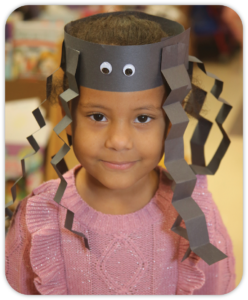
Nobody Likes Me
Sometimes your child may feel that no one feels the way she does. Understanding that it is okay to have different feelings is important. This silly song “Nobody Likes Me” is a great way to start a conversation about feelings. Click image for lyrics. Note: Remind your child that it is not okay to eat worms.
Daily Message
I examined a spider in a box. I saw a scorpion at the zoo.
- Say the sentences. Ask your child to repeat them.
- Write the sentences as your child recalls each word.
- Have your child point to the uppercase letters at the beginning and the punctuation marks at the end.
- Write the letters w, x, and z below the sentence. Invite your child to find and circle these letters in the sentence.

Writing Together
Ask: What does it mean to be busy? Share an activity you do that keeps you busy: I am very busy when I am fixing dinner. Write the sentence: I am very busy when __________ . Have your child share an activity that keeps him very busy. Write the activity to complete the sentence. Read the sentence aloud moving your hand under the print.

Storytime
Read pages 10-11 in Spiders, Scorpions, and Worms. Look at each photo and read the captions. Talk about the ways spiders use their webs (catch a meal, wrap up a meal to save it, make a net for catching, soft blanket for eggs, parachute).
Grab a Handful
Ask your child how many clothespins or rocks will fit in her hand. Have her make a guess (estimate). Then have her grab a handful. Have her match each object she grabbed to the fingers on one hand. Ask: Did you grab more, fewer, or exactly five? How do you know? Was your estimate close to the number you grabbed?
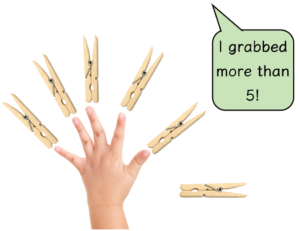
Wonderful Webs
Help your child find a spiderweb outdoors. Look on tree branches, bushes, flowers, gates, and in waterspouts. Stress the importance of only looking and not touching. Once your child has discovered a web, have her draw what she sees using white chalk on black paper. Study the detail and beauty. Note: It is easier to find webs in the early morning when dew is on them.
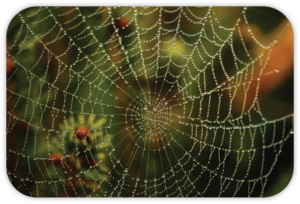
Find a Letter
Throughout the day, encourage your child to notice and name alphabet letters. Look at a sign on a store or restaurant, the school, or a book. Point to a letter and say: I see a z in that word—pizza. Encourage your child to find and name another letter.
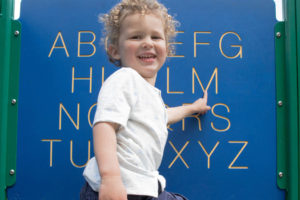
Listening Ears
During your learning time together, one of the commitments you choose is Listening Ears. Ask: When are some other times when it is important to use Listening Ears? Today, have your child use her listening ears outside to see if she can hear any insects.

Daily Message
Busy spiders create amazing webs.
- Say the sentence. Ask your child to repeat it.
- Write the sentence as your child recalls each word.
- Have your child point to the uppercase letter at the beginning and the punctuation mark at the end.
- Write the letters w, z, and y below the sentence. Invite your child to find and circle these letters in the sentence.

My Journal
Read the book What Is This? Explain that the character on the cover is Fanny Frog. She has many questions for the reader. Together read each question page. Have your child name the pictures on answer pages. When you have finished reading, have your child draw and label one of the creatures from the book in her journal.
Storytime
Watch the Spiders, Scorpions, and Worms read-aloud video. Today focus on how these creatures can help us. Ask: What was the important message at the end of the book? (Don’t be afraid of these creatures but do leave them alone and don’t touch them.)
How Many More?
Help your child figure out what happened to the worms in a number story. Have your child draw a picture of soil and grass (story mat). Divide the mat into three sections. Use short pieces of yarn or chenille stems as the worms. Tell the beginning and the end of the story. Your child will have to decide what happened in the middle. Click image for story.
Compare Dots
Use the 0-5 dot cards your child made earlier. If the cards are lost or damaged, make new ones. Mix up the cards and place them face down. Play with your child. Each of you will take one card from the top of the deck. Compare the cards. Ask: Which has more dots? How do you know? Continue until all cards are played.


Critter Bite Care
Review steps for taking care of a critter bite:
- Move away from the area where the bite or sting happened.
- Have an adult remove a stinger using tweezers or by raking a stiff card over the area.
- Wash the area with warm, soapy water. Dry with a towel.
- Apply a cool compress.
- Apply anti-itch cream if needed.

Dig for Worms
Carefully dig a hole in the garden or a flower bed in search of worms. Remind your child that earthworms help keep the garden healthy. They keep the soil loose around plants. Worms live underground to protect themselves from sunlight. After looking at the worms, gently cover them with soil.
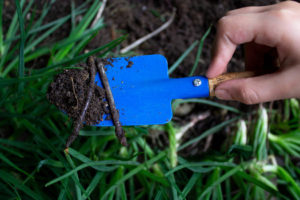
Don’t Be Afraid
Many people are afraid of spiders and scorpions. Spiders and scorpions don’t like people either. They would rather go away than fight or sting. Teach your child two simple rules:
- Don’t stick your hands into places you can’t see.
- Don’t touch or poke spiders, spider webs, or scorpions.
If you leave these creatures alone, they will not hurt you.

Daily Message
Large scorpions eat lizards and worms.
- Say the sentence. Ask your child to repeat it.
- Write the sentence as your child recalls each word.
- Have your child point to the uppercase letter at the beginning and the punctuation mark at the end.
- Write the letters z, w, and s below the sentence. Invite your child to find and circle these letters in the sentence.

Writing Letters
Focus: Ww, Xx, Yy, Zz
Review how to write the letters. Have your child watch as you write a letter saying the strokes. Have your child write the letter with a finger on the floor repeating the strokes. Then have your child practice writing on paper. Repeat for each letter. Click image for letter formation strokes.
Itsy Bitsy Spider
Have your child choose whether she would like to be the little spider or the encourager. You take the other part. Sing “Itsy Bitsy Spider” with Thomas Moore and act it out as you sing. Ask: Who might the encourager be? (spider’s parent, friend, watching child) Click image for lyrics.
Storytime
Read The Very Busy Spider. After reading, point out that spiders, like all other living things, have a life cycle (stages of development). Explain a spider’s life cycle to your child. Click image for photos of the three stages of this cycle.
Copy Game
To play this game, you and your child will each take one card from a stack of 0-5 dot cards. Connect paper clips to make a “worm” as long as the number of dots on your card. Compare worms. Change the number of paper clips in your worm to match your child’s worm. Ask: Will I need to remove or add paper clips? How many? Play again.


Scorpion Pincers
Turn to pages 12-13 in Spiders, Scorpions and Worms. Review the facts about scorpions in the captions below each photo. Ask your child to find the pincers on each scorpion. Explain that scorpions use pincers to grab food. Invite your child to use a clothespin or tweezers to pick up small objects around the house. Ask: Which objects were difficult to grab? Why?




